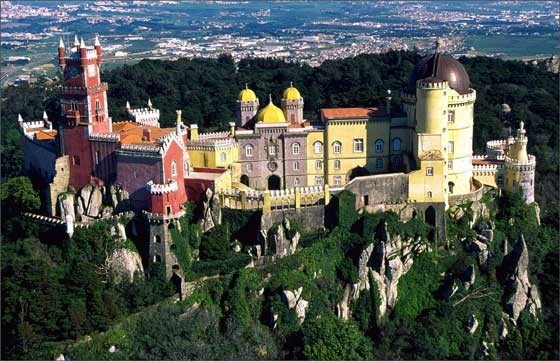By Mitchell Smyth
Meridian Writers’ Group
SINTRA,
Portugal—The year is 1809. Lord Byron, who would soon become England’s
greatest poet of the Romantic age, is on his “Grand Tour” of Europe, the
journey he will immortalize in his epic poem, Childe Harold’s Pilgrimage.
In this celebrated hill
town 30 kilometres northwest of Lisbon, he’s ecstatic over the scenery. “It
contains beauties of every description, natural & artificial,” he writes to
his mother. “Palaces and gardens rising in the midst of rocks, cataracts and
precipices, convents on stupendous heights...”
I couldn’t have put it
better myself.
Today, in Sintra’s
Lawrence’s Hotel, a portrait of Byron gazes down on the room in which he wrote
those words. “We know this was his room because he carved his name on the
windowsill with his diamond ring,” says a hotel spokesman. “The sill was there
until the hotel was renovated in 1945. It’s now in America.”
Lawrence’s is an
excellent base from which to explore Sintra, and you must explore for it’s as
pretty a town as you’ll find in Europe. You’ll agree with Byron, who called it
his “glorious Eden” and wrote (in Childe Harold) about, “The horrid crags, by
toppling convent crown’d/The oak trees‚ hoar that clothe the shaggy deep...”
In all, he said in a
letter home, Sintra “united in itself all the wildness of the Western Highlands
(of Scotland) with the verdure of the South of France.” It still does.
Lawrence’s is at the edge
of Sintra’s historic centre, which has been designated a UNESCO World Heritage
Site. From the hotel, the road rises steeply to the Pena Palace, one of several
jewels in Sintra’s crown. Although Byron doesn’t mention it specifically, we
can be pretty sure that he visited it on one of his walks. (“Then slowly climb
the many-winding way/And frequent turn to linger as you go”—Childe Harold.)
Perched on a plateau above the town, it is truly a castle in the sky: a rococo
dream of towers and turrets and domes in ochre, yellow and burnished copper.
Pena Palace was last
occupied by Queen Amelia, mother of the king, Manuel II. They fled the country
in 1910 just before a revolution turned Portugal into a republic. The palace
remains much as Amelia left it, giving us an insight into royal life in
Portugal a century ago. Other windows into Sintra’s past include the National
Palace, the Moorish Castle, the Convent of Santa Cruz and the Regaleiga Palace
and Gardens.
Lawrence’s Hotel dates
from 1764, when Jane Lawrence, an eccentric English innkeeper, arrived in
Sintra. Byron’s writings gave it and Sintra a massive boost in the 1800s, and
it was a “must” stop for aristocracy and gentry on the “grand tours” of Europe
in the 19th century. It fell on hard times in the 20th century before Jan
Willem Bos and his wife Coreen, from Holland, bought it, sank millions on
restoration, and reopened in 1999.
Visitors over the past
six years include Queen Beatrix of the Netherlands, former United States
president Bill Clinton and current British prime minister Tony Blair.
ACCESS
For information on travel
in Portugal visit the Portuguese Trade and Tourism Commission website at
www.visitportugal.com
.




